A complete detail of Mustard seed
Mustard seeds (सरसों के बीज) are the small round seeds of fruit pods mainly obtain from several spices of mustard plants in the Brassica family. Mustard seeds are basically the small round seeds of three different plants: black mustard, brown Indian mustard, and white mustard. The seeds are usually about 1 to 2 millimetres (0.039 to 0.079 in) in diameter and may be colored from yellowish white to black. mustard seeds are a common ingredient in Indian cooking and mainly cultivated for its oil
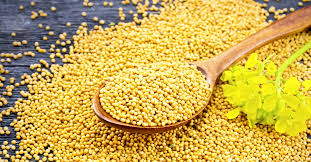
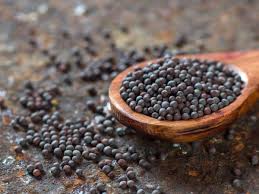
Pic source-Christianity.com & times of india
About mustard plant:-
Mustard is a rapeseed group of crop which belong to Brassica family plant and it is considered the oldest plants in the human civilization. Biologically rapeseed and mustard plants both belong to the crucifarae family and under the genus of Brassica with large number of spices and sub-spices cultivated in india. Being a number of Brassica family rapeseed is closely related to mustard.
The word rape comes from the latin word “rapum” which means Turnip whereas the world mustard is derived from the latin word “mustum” means unfermented grape juice with ground mustard seeds. Then word mustard was derived from the Latin phrase “mustum ardens” which roughly translates to “burning wine”.

The mustard and rapeseed are closely related to each other and can share the same growing areas. Rapeseed & mustard seed are cultivated mainly for its oil-rich seed which naturally contains appreciable amounts of toxic erucic acid.
Rapeseed crop is known by different names in different places e.g. sarson, toria, or lahi, while mustard seed is known as rai, or raya or laha. Rapeseed/Toria and mustard are the third most important edible oilseed crops of the world after soybean and oil palm.
Classification of rapeseed -mustard seed
| Botanical & English Name | Origin |
| Botanical Name: – Brassica juncea English Name: -Indian mustard/brown mustard, Rai, Rayada, Laha |
|
| Botanical Name: – Brassica rapa English Name: -Indian Rape, Rapeseed, brown sarson/Toria, Tori,Lahi |
|
| Botanical Name: – Brassica rapa English Name: – Rapeseed, yellow sarson, pilli sarson |
|
| Botanical Name: – Brassica nigra English Name: – Black mustard |
|
| Botanical Name: – Brassica Napus L. English Name: – Rapeseed, Gobhi sarson |
|
| Botanical Name: – Eruca sativa English name:- Taramira /Rocket salad |
|
Rapeseed are used widely for animal feed and vegetable oil whereas mustard seed are used as a condiment or a spice. Brassicas are cultivated during rabi (October to April) because of its low temperature requirement.
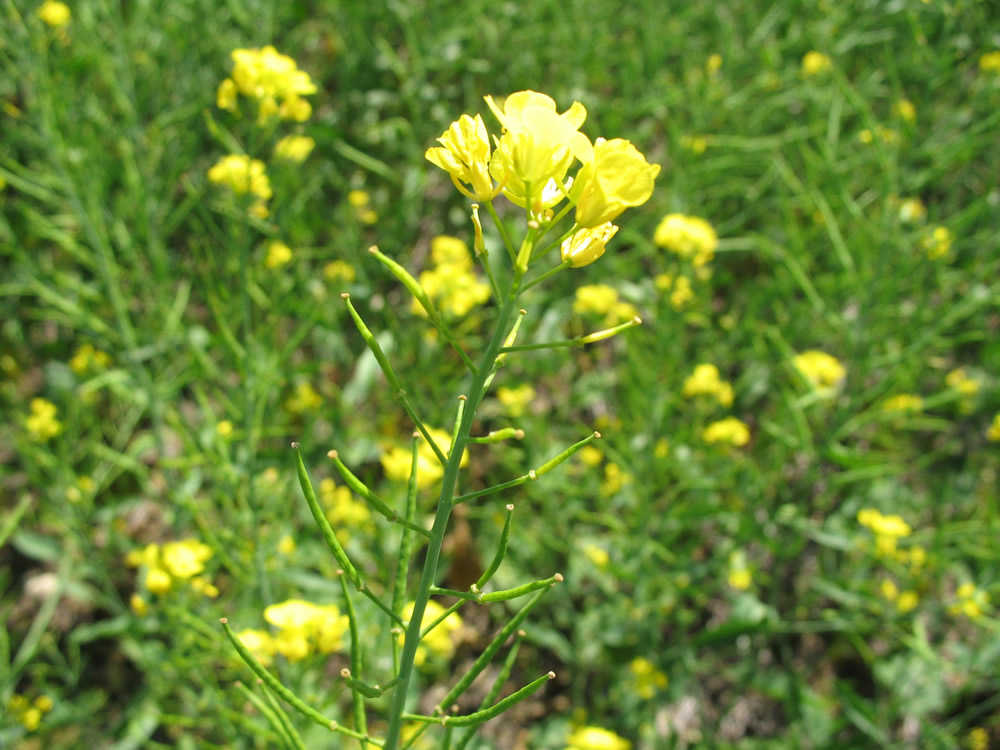
Pic source-saskatchewan mustard development council
The primary use of mustard seed/Rapeseed is for extracting oil while the seeds are also used as condiment in pickles, meat and salad dressings. Mustard seed can also be milled into mustard flour and used as an ingredient in processed foods, such as salad dressings and soups. The seeds when crushed yield around 27-33% of oil. Rapeseed oil has been used for centuries as a crop for a variety of uses. It was initially burned as oil in lamps by our ancestors in Asia and Europe, and later was discovered as cooking oil which people used to cook a number of items. The oilcake is mostly used as cattle feed.
A brief history of cultivation of mustard seed
The mustard originated in China and from there, it was introduce to India around 3,000 BC. In about 1300, the name “mustard” was given to the condiment made by mixing mustum, which is the Latin word for unfermented grape juice, with ground mustard seeds. Then word mustard was derived from the Latin phrase “mustum ardens” which roughly translates to “burning wine”.
Ancient Romans were occasionally used the mustard seeds to flavor their food as the same way that as cracked black pepper. Ancient Greeks and Romans enjoyed mustard (sinapis) seed as a paste and powder. To create mustard condiments, “the Romans used to ground mustard seeds and mixed them with wine to make into a mustard paste. The Greeks used Mustard as a medicine and a spice.
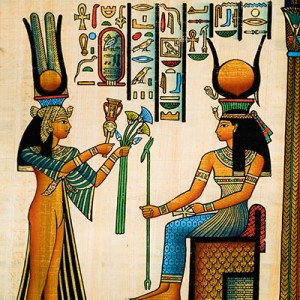
Pic source-gsdunn.com
. Between 400-700 AD, the Romans then introduced mustard seeds to the people of Celtic Gauls Monks. These monks lived in the region that is modern day France, Belgium, Lexemburg, Netherland, Switzerland and Germany.
These monks used to plant these mustard seeds in their grape vineyards and after cultivation they used to mix the ground mustard seeds with unfermented wine, known as “must” to flavour it.
In the late 1700s, two men from Dijon, France – Maurice Grey and Antoine Poupon, established a company using Grey’s mustard recipe. The House of Maille has been making mustard and vinegars since 1747 in Paris. Benjamin Franklin, who was the ambassador to France, is believed to have brought some of their mustard to America when he returned in 1758. In 1720, the modern period of the mustard seed started. From this period, the mustard seed is used in the cooking and preparing process of mustards. These mustard seed is largely consumed by the people of America.
In 1866 Jeremiah Colman, founder of Colman’s Mustard of England, was appointed mustard-maker to Queen Victoria.5 Colman perfected the technique of grinding mustard seeds into a fine powder without creating the heat that brings out the oil. In the early 19th century, the British became the world’s first mustard millers – milling the heart of the mustard seed to a fine powder and they established mustard as an industrial food ingredient.
The yellow Mustard that we know today was introduced in Rochester New York in 1904 where its pairing with the American hotdog gave rise to its popularity.
Types of Mustard seeds: –
There are over forty different varieties of mustard plants, but there are basically three types of mustard seed grown world wide for culinary use:-
- White or yellow mustard obtain from Sinapis alba mustard plant belong to southern Mediterranean origin,
- Brown or Indian mustard obtain from Brassica juncea mustard plant belong to Himalayan origin
- Black mustard which is obtain from Brassica Nigra plant.
What is white or yellow mustard plant: –
White mustard also commonly known as yellow mustard (Peeli sarson) is obtain from the Sinapis alba or Brassica alba spices of mustard plant. Its Seeds are much larger than the brown mustard seed variety, but has less pungent taste as compare to brown or black mustard seed. It has milder flavour and good preservative qualities due to this reason it is mainly used for condiments purpose. It is grown across much of Europe and North America. This is the mustard seed mostly used in European cooking.
It is also grown in India and used in Indian cuisine wherever a milder flavour is desired.
| Picture of white or yellow mustard plant & its seed | |
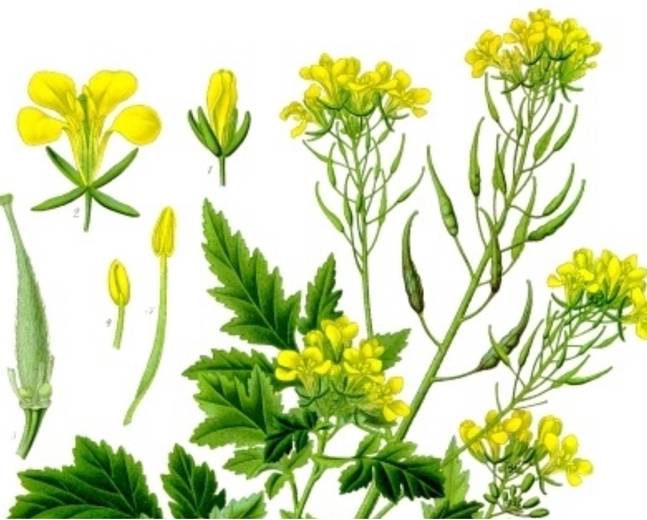 | 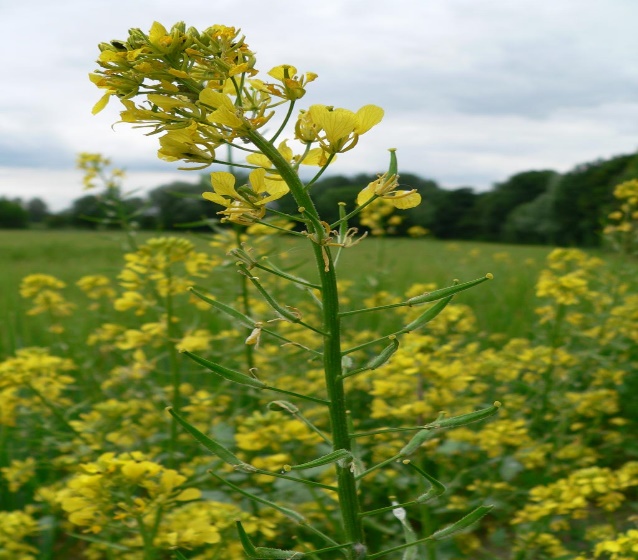 |
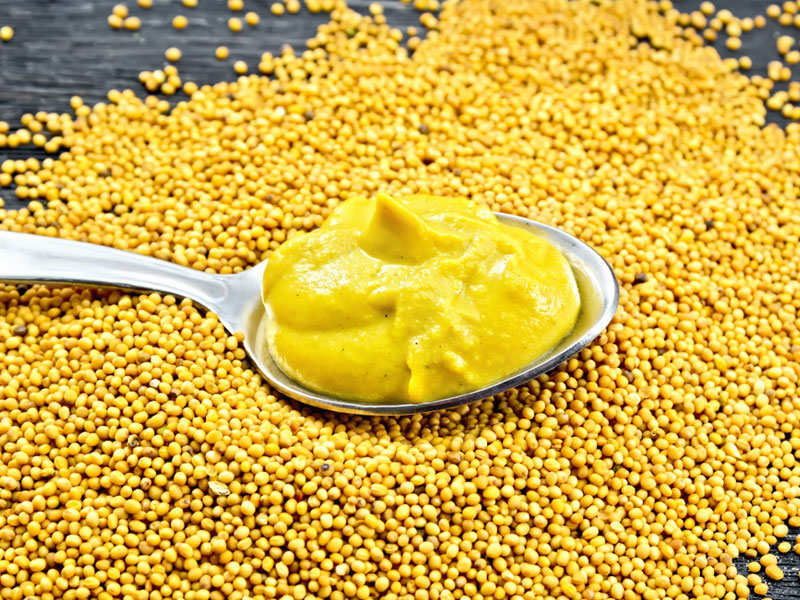 |  |
Brown Mustard Seeds
Brown or Indian mustard obtain from Brassica juncea mustard plant belong to Himalayan origin. It has reddish-brown color and has also been grown and used in India since ancient times. Although these are often referred to as Black Mustard Seeds, but are a different variety. Brown mustard seeds are similar in size to the black variety and can vary in colour from light to dark brown. They are more pungent than the white, less than the black. Brown mustard is often favoured over black mustard in European production due to the ability to mechanise harvesting.
| Picture of Brassica Juncea mustard plant/Brown mustard plant & seeds | |
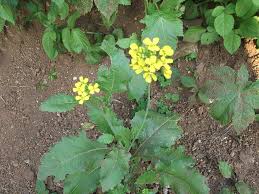 | 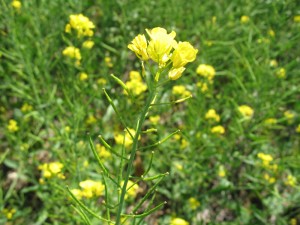 |
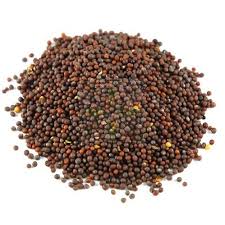 |  |
Brown and black mustard seed is very popular in Indian cooking. It is grown widely in India and is particularly suited to spice mixes. In India mustard seeds are tempered in hot oil to bring out their nutty flavour. They are sauteed in hot ghee or oil until they pop and release their flavours – less than 30 seconds, depending on the quality of the seeds and the temperature of the oil. They are also planted to grow saag (greens) which are stir-fried and eaten in vegetable preparations.
In China, the brown mustard plant is used as a vegetable – mustard leaves. The plant has swollen, fleshy stems and leaf bases, and it is cured with salt and chilli paste and left to ferment.
What is black mustard plant:-
black mustard plant:- The botanical name of this plant is Brassica nigra, is an annual plant cultivated for its black or dark brown seeds which are commonly used as a spice. It is native to tropical regions of Middle east and also grown in temperate regions of Europe, and parts of Asia. At one time in Britain, black mustard seeds are extensively cultivated in the Lincolnshire and Yorkshire area. Major producers of black mustard seed in today’s world include Hungary, Britain, India, Canada (90%) and the United States.
Black mustard seed is a round, hard seed, slightly larger and slightly stronger in flavour than the Brown Mustard Seeds, with a brownish-black colour. The black mustard seed has been replaced for most purposes by the brown species because the latter can be grown and harvested more economically.
They have little fragrance, but have a pungent taste after chewing and a nutty odour after roasting. They are native to Southern Europe and western Asia. It is endemic in the Southern Mediterranean, India and Middle East. It is little planted in Europe anymore.
| Picture of Black mustard plant & seeds | |
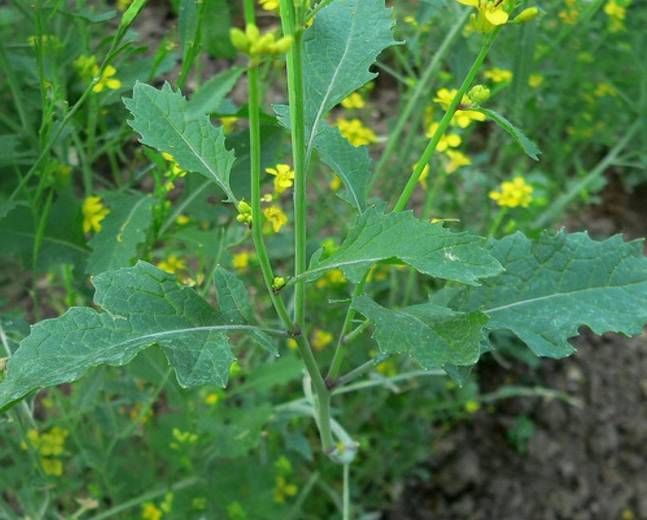 |  |
 |  |
Bengali’s use black mustard seeds in panch phoron, and in South India it is used in sambhar powder. In South India the seeds are fried or roasted until they pop and turn grey before use and this changes their character to a nutty taste. As black mustard seeds pungency is destroyed by other methods of cooking, it is added as late as possible to dishes.
Common name of mustard seed in India:-
- Mustard seed in English
- Sarson/Rai/Banarasi rai/kale sarson in Hindi, Punjabi & Urdu
- Rai in Gujrati
- Sasave in kannada
- Sorisa or kaduku in Malayalam
- Kadugu in Tamil
- Avalu in Telgu
- Aasur in Kashmiri
- Asuri in Sanskrit
Flavour profile of mustard & Rapeseed seed:-
Mustard seed contain an enzyme called myrosine which is the main component responsible for pungent taste in mustard. This myrosine enzyme is generally activated with water that is the reason it is usually grinded with water to make a mustard masala or paste. Thus, when cooked in oil, the taste of the seeds will remain subtle, and add a less pungent flavor to things such as curry pastes. Apart from water we can also soak mustard seed in beer, wine, vinegar to get typical flavour.
The whole mustard seed has no flavour, but can provide a pungent taste after chewing. The heat experienced in yellow mustard is on the tongue, whereas in brown and black mustard the heat is also felt in the nose and eyes. The severity of pungent aroma varies with different mustards. The white or yellow type has a less pungent aroma than brown mustard seeds. Brown mustard have higher pungency than yellow mustard whereas Black mustard seeds have the highest pungency.
The enzyme myrosinase, in the presence of water, breaks down the glycoside (sinal-bin) in yellow mustard or sinigrin in black or brown mustard to para-hydroxybenzyl isothiocyanate, which is responsible for the characteristic pungent aroma. The odours last until the enzyme activities ceases.
Freshly prepared mustard is the hottest and most pungent, so you typically need to allow mustard to age for a certain period of time, to mellow the flavors. The longer it sits, the milder the flavor becomes.
When cooked in oil the taste of mustard seeds will remain subtle, adding a less pungent flavor to things like curry pastes, sauces, or stews. As with most seeds, toasting excites the seeds’ volatile oils and helps release their aromatic flavor. After toasting, mustard seeds mellow out and can be incorporated into a sauce or dressing to provide a nutty, earthy flavor as well as a bit of texture.
When crushed, they are nose-tinglingly pungent. However, if they are roasted they turn quite nutty and sweet.
Production of Rapeseed and Mustard around the world:
Rapseed and mustard are grown extensively in more than 53 countries in the world. China, India and Pakistan account for about 90 per cent of the world production. Other major rapeseed and mustard producing countries are Canada, Germany and France. India occupies the second position in area and third production in rapeseed and mustard in the world. In India, rapeseed and mustard account for 27 per cent of the total oilseeds area and 31 per cent of total oilseed production.
Production of mustard seed and Rapeseed in India-
In India it is mainly grown in Indo-gangetic plains. The major mustard seed producing states are Rajasthan, Uttar Pradesh, West Bengal, Madhya Pradesh, Haryana, Assam, Gujarat, Bihar, Punjab and Orissa. The mustard crop grows well in areas having 25 to 40 cm of rainfall. Sarson and toria are preferred in low-rainfall areas, whereas raya and toria are grown in medium and high-rainfall areas, respectively.

In India, rapeseed and mustard are grouped together. The oil content in these seed are vary from 37% to 49%. Rapeseed can yield 1.4 to 2 tones per hectare of land whereas mustard seed can yield 2-2.5 tones per hectare of land.
International acceptability of Indian mustard seed & Rapeseed as compare to hybrid canola seed.
The traditional mustard-rapeseed grown in India contains high amount of erucic acid and glucosinolates. The researchers found that consumption of erucic acid in oil has negative effect on health resulting Indian mustard and rapeseed does not conform the international standard of ‘canola’ quality due to high erucic acid and glucosindolates contain in it as compare to the canola seed which was developed by cross breeding by Canada. Hence, at present the government agencies in Punjab are promoting the cultivation of hybrid mustard rapeseed namely, ‘Hyola’as a drive for the crop diversification programme by Govt. of Punjab since 2003 onwards.
How compound mustard is made:-
Compound mustard is made by combining any type of mustard seeds whether it is white or yellow, brown and black mustard etc with different liquids such as vinegar, wine, lemon juice with flavouring ingredients such as honey, tarragon, Pepper & salt to make a paste with a sauce-like consistency. The ingredients in compound mustard are vary greatly in country to country.
Example of popular compund mustard used in the culinary world: –
- Dijon mustard:- Dijon mustard is a style of prepared mustard that originated in the city of Dijon, which is the capital of the Burgundy region of France in the eastern part of the country. It has a pale yellow color and slightly creamy consistency. One of the most popular brands is Grey-Poupon. Dijon mustard has a tangy, sharp, and strong flavor with a bit of spice.
Ingredients in Dijon mustard:– Dijon mustard is made from brown mustard seeds and white wine. One of the crucial ingredients in traditional Dijon mustard is verjuice. This tart liquid gives Dijon mustard its characteristic flavor. The original recipe includes white wine from the Burgundy region, like Chablis or Bourgogne blanc (which are made from Chardonnay grapes). The basic ingredients in Dijon mustard are-Brown mustard seed, vinegar, sugar, salt, egg yolk, white wine, garlic & onion.
Culinary use of Dijon Mustard:- it is used as a condiment & spread on hot dogs or sandwiches. It is also used in marination for roasting of red meat items.
It is one of the main ingredients in the preparation of Vinaigrette dressing or salad dressing and can also be flavoured to many sauces.
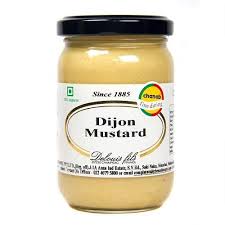

- English mustard:- English mustard is a mix of yellow and brown mustard seeds. English Mustard is quite hot. It comes either as a powder in a tin, or as a prepared mustard in a jar.it is generally sold in compound mustard powder form which is made from mixture of white mustard seeds & brown mustard seed mixed with wheat flour for bulk and turmeric for colour. It is a speciality of England and rarely seen elsewhere. It has a bright yellow colour, and a strong, sharp flavour that is somewhat bitter and pungent rather than hot.
The most famous brand of English mustard is Colman’s, which first produced their variety in 1814 as a powder in their yellow tin- it is also available as a paste.
Culinary use of English mustard:-it is usually used as a dipping sauce, ideal for breaded or fried foods, spread in hamburger, sandwich, hotdogs, tacos etc. it is often uses as a table condiments.
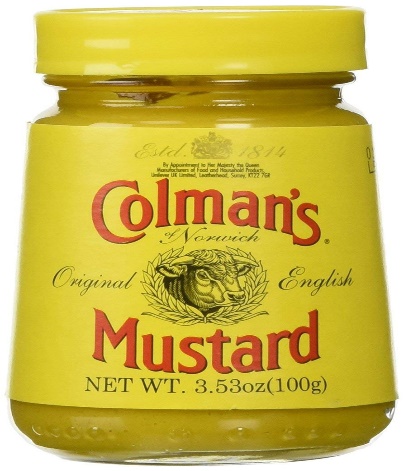
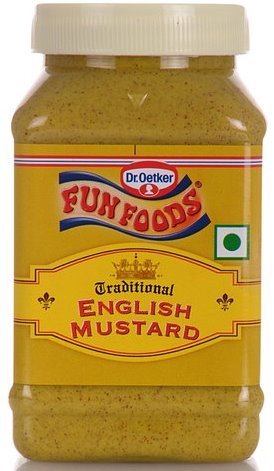
- German mustard:- it is Known as senf or mostrich in German. German mustard is made with different varieties of ground mustard seeds (mostly Sinapis hirta and Brassica nigra) mixed with vinegar, oil, herbs and/or sweeteners. It ranges from smooth to coarse-ground, and from pale yellow to brown in color.
The two most famous German mustards are Düsseldorf and Bavarian Sweet. The main difference between these two varieties is that Bavarian Sweet keeps with its namesake, while Düsseldorf has more of a sweet-sour taste.
Bavarian mustard is made from coarsely ground and roasted mustard seeds mixed with vinegar and honey, sugar or applesauce as a sweetener whereas Dusseldorf mustard is made with a combination of yellow and brown mustard seeds and is the most popular style in Germany.
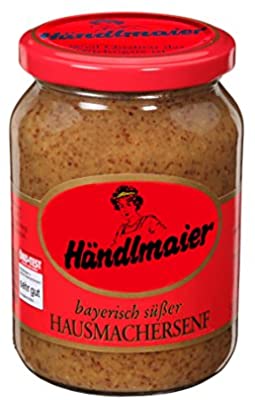

Pic source-amazon.co.uk
- Meaux mustard:- Meaux mustard is very famous in all over France. It is prepared from canola mustard and make into paste with ingredients such as salt, spirit vinegar & spices. It is generally packed in old fashioned sandstone pot with a cork on the top and sealed with red wax. It is wonderfully goes with meat and also ideal for preparing of sauce and vinaigrette dressing. This condiments first appeared in Meaux in the 18th century.
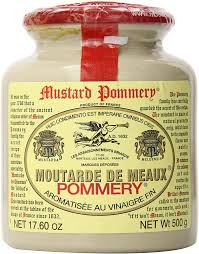

Pic source-Gerald.ph & amazon
- American ballpark-style mustard:- Yellow “ballpark” mustard. Made from yellow mustard seeds and colored by turmeric, American “ballpark” style mustard is essential for eating hot dogs, emulsifying salad dressings and pan sauces. They are not as hot and flavorful as English or Dijon mustards.
It is Delicious, mild, smooth-textured mustard containing 24% mustard powder in a handy squeeze bottle. American Mustard is perfect for American food like hot dogs, burgers, chicken wings, grilled turkey & other meats.

Pic source-pepper.ph
- Bordeaux mustard:- Bordeaux mustard is made from black seeds blended with unfermented wine. The seeds are not husked, producing a strong, aromatic, dark brown mustard often flavoured with tarragon.
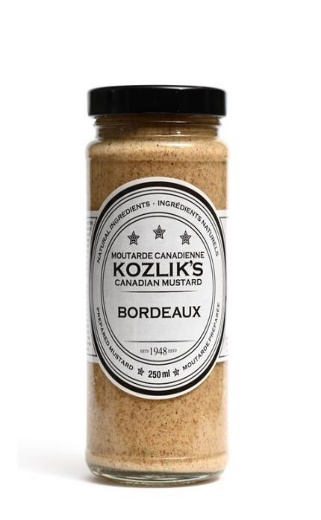
Culinary use of mustard seed:-
Whole white or yellow mustard seed are basically used in pickling and in spice mixture for cooking meat & seafood.
Cooking With Mustard Seeds
The mustard seeds used in Indian cooking are tiny and black or dark brown in color. The seeds have a faint spicy smell much like curry leaves. They taste just like mustard in its paste form.
Mustard seeds are a common ingredient in European and Asian cooking to make dishes like curry, dal, but can easily be incorporated into stir-fried vegetable dishes. If you are going to cook with mustard seeds, be sure to toast them first, otherwise, they will taste too bitter.
Black mustard seeds are most common ingredient used in Indian cooking. It is often used whole to fried (or toasted) in hot oil or ghee before adding to any dish while cooking or stir-fry along with other aromatic spices.
In Indian cooking, Rai/Sarson is often part of the Tadka in a dish. In comparison, Rai/Sarson is used more in South Indian than in North Indian cooking. In the South, it is typically combined with green chilies and curry leaves in a tadka. It is sometimes used in paste form, for example in Eastern Indian dishes like Deemer Patudi or fish curries.White mustard seeds can be toasted to add to dishes or used for pickling.
In the eastern regions of India, mustard seeds are often paired with fish dishes, and also it is one of the main ingredients in Bengali five mixture spices called Panchphoron. Due to its pungency flavour it is highly regarded in preparation of fish masala used to prepare various fish curry dishes. It is also used in every household in their traditional masala for preparation of vegetarian dishes.
In the west part of india it is usually used to perk up with yoghurt and Rice dishes as well as Gujrati coconut curries. Mustard seed also provide a base flavour in several Rajasthani curries. Punjab and J&K region often cooked their meat dishes in mustard oil.
In southern part of india, mustard seed are used in almost all types of vegetarian dishes be it to temper the coconut chutney or in the preparation of sambhar to porial dishes. It is one of the main ingredient in south indian curry powder. In south india, mustard seed or Rai is often combine with curry leaves, red chilly whole to tempered the south indian dishes.
Mustard seed goes well with yoghurt or dahi that is the reason it is also used in the preparation of several Raita.
Mustard seed is most commonly used for making compound mustard paste or powder for use as table condiments or marinades. Brown mustard seeds are to make Dijon mustard and other specialty mustards paste in all over the world.
Mustard flour has preservative and antioxidant properties in addition to providing flavour and colour. In salad dressings, the most important property of the spice is its emulsifying function, binding water and oil phases as well providing viscosity. whole mustard seeds are also used in the preparation of sauerkraut.
Mustard seeds can be used in several ways such as it can steeped in warm milk, whisked into salad dressings, it can be grounded , sprinkled into warm food dishes and used to make several mustard paste or powder commonly knows as compound mustard.
Ayurvedic properties of mustard Seed:-
According to Ayurveda, mustard seeds are hot potency, pungent, sharp nature and bitter taste which helps in cutting excessive khapa energy and aggravate pitta dosha. Also brown mustard seed are considered as a digestive and good for alleviating stomach discomfort such as gas and cramps.
Health benefit of mustard seed:-
Mustard seed are low in calorie and high in Nutritional value as it has lot of antibacterial and antiseptic qualities. The seeds are excellent source of minerals such as magnesium, calcium, potassium and phosphorus. It is a great source of dietary folate and Vitamin A.
It is rich in nutrients called selenium which is known for its high anti-inflammatory effects. The high content of magnesium in mustard seed also helps to reduce the severity of asthma attack and also helps in lower our blood pressure.

